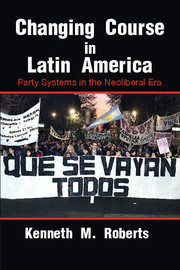Book contents
- Frontmatter
- Dedication
- Epigraph
- Contents
- List of Figures
- List of Tables
- Preface and Acknowledgments
- List of Abbreviations
- 1 Introduction: Party System Change in the Neoliberal Era
- Part I Explaining Regional Patterns
- 2 Partisanship and the Puzzle of Party System Stability
- 3 Critical Junctures and Party System Change
- 4 Antecedent Conditions: Party System Differentiation in 20th-Century Latin America
- 5 Neoliberal Critical Junctures and Party System Stability
- 6 Programmatic (De-)Alignment and Party System Stability in the Aftermath Period
- Part II National Experiencesin Comparative Perspective
- Appendix Election Results in Latin America
- References
- Index
3 - Critical Junctures and Party System Change
Published online by Cambridge University Press: 18 December 2014
- Frontmatter
- Dedication
- Epigraph
- Contents
- List of Figures
- List of Tables
- Preface and Acknowledgments
- List of Abbreviations
- 1 Introduction: Party System Change in the Neoliberal Era
- Part I Explaining Regional Patterns
- 2 Partisanship and the Puzzle of Party System Stability
- 3 Critical Junctures and Party System Change
- 4 Antecedent Conditions: Party System Differentiation in 20th-Century Latin America
- 5 Neoliberal Critical Junctures and Party System Stability
- 6 Programmatic (De-)Alignment and Party System Stability in the Aftermath Period
- Part II National Experiencesin Comparative Perspective
- Appendix Election Results in Latin America
- References
- Index
Summary
The process of market globalization – understood as the transnational integration of markets for goods, services, and capital – is inevitably shaped by the particularities of world regions (Katzenstein 2005; Stallings 1995), including their distinctive patterns of political development and their modes of insertion in the global economy. The realignment of states, markets, and social actors associated with globalization and market liberalization in late 20th-century Latin America occurred in a context of redemocratization that inevitably imposed major adjustment burdens on political parties. Although democratization restored parties to political prominence after extended periods of military rule, the “dual transitions” to democracy and economic liberalism were deeply unsettling to party systems in much of the region.
The economic crises of the early 1980s undermined military governments and helped trigger democratic transitions (see Remmer 1992–1993), but they also imposed political costs on incumbent parties after democracy had been installed. Although the ensuing process of market liberalization may have contributed to the stabilization of new democratic regimes by defeating hyperinflation and forging a technocratic consensus in key areas of public policy, it also eroded many of the social and programmatic linkages that bound parties to popular constituencies. Indeed, market liberalization inevitably clashed with modes of political representation that had been forged during a half-century of state-led capitalist development.
- Type
- Chapter
- Information
- Changing Course in Latin AmericaParty Systems in the Neoliberal Era, pp. 41 - 64Publisher: Cambridge University PressPrint publication year: 2015



